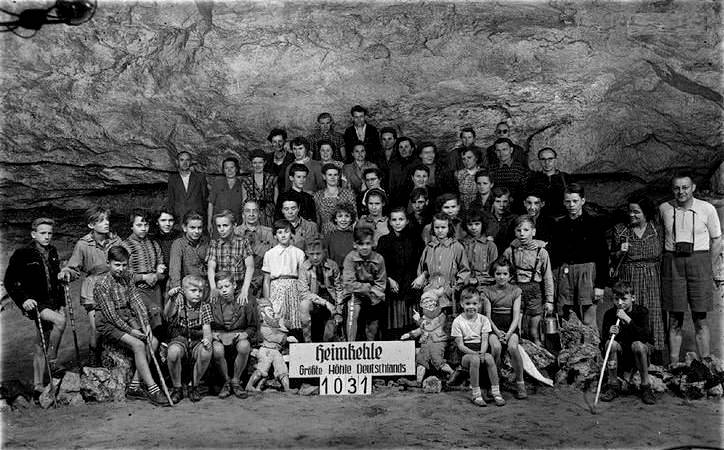
German Family Activities: Vacation and Tourism

Figure 1.--The German Economic Miracle revived the country's tourism industry. Germans during the 1950s began visiting domestic attractions. And workers now had cars and could easily reach even isolated attractiins. The sign here says, "says in German: HEIMKEHLE. Größte Höhle Deutschlands". That means, "HEIMKEHLE. Germany's largest cave. The name Heimkehle must be just a name without much meaning, possibly something local. The original name was Heimekenhöhle, a plaster cave in central Germany.
|
|
The history of tourism in Germany begins with the grand tours that the wealthy began to take in the late-18th century. Those participating in the grand tour sought out cities with notable attractions as well as senic landscpes. Dresden, Munich, Weimar and Berlin became major stops on a European Grand tour. This was disrupted by the French Revolution and subsequent Napoleonic Wars. After the Napoleonic Wars, especially by mid-centuty, Germany began to be transformed by the industrial revolution and railroads. Spas and resorts located along the North and Baltic Seas andas well as the senic Rhine valley began to develoop as populr tourist sites. The ailroads mean that these sites could easily be reached in a short, inexpensive trip. This mean ghat the middle-class for the first time could have a vacation and visit tourist sites. In Britain, even the working-class could enjoy trips to beach resports. We are less sure to what extent that tourism was available to the German working class. After World War I, the NAZIs gave considerable attention go developing tourism and making it available go a broader spectram of society than ever before. Hitler signed a law creating the Reich Committee for Tourism (June 23, 1933). It was establishished in the Ministry of Propaganda. Tourism had a range of attractions for National Socialism. There were many interesting historical sites and Hitler and other leading NAZIs had a sense of hidtory. There was also a mystical attachment with the countryside. And it could be provide workers an enjoyable experience without drawing significant resources from the rearmament program. In fact, it was seen as rejuvenating workers for renewed work in the war plants. [Semmens] The major promotion occurred through Dr. Robert Ley and his Deutsche Arbeitsfront (German Labor Front--DAF). The program was Kraft durch Freude (Strength through Joy organisation--KdF). Tourism collapsed during the War and early post-War era. This changed with the German Economic Miracle which by the 1950s rapidly brought prosperity to German workers as well as the middle-class. At first yhis meant tourism within Germany. By the 1960s, German tourist began to venture abroad, at first to Italy. Cheap air fares enabled trips to sunny spots like Spain.
Sources
Semmens, Kristin. Seeing Hitler's Germany: Tourism in the Third Reich (Basingstoke, Palgrave Macmillan, 2005).
HBC

Navigate the Boys' Historical Clothing Web Site:
[Return to the Main German activities page]
[Introduction]
[Biographies]
[Chronology]
[Clothing styles]
[Countries]
[Photography]
[Bibliographies]
[Contributions]
[FAQs]
[Glossaries]
[Images]
[Links]
[Registration]
[Tools]
[Boys' Clothing Home]
Created: 8:51 AM 11/22/2011
Last updated: 8:51 AM 11/22/2011



